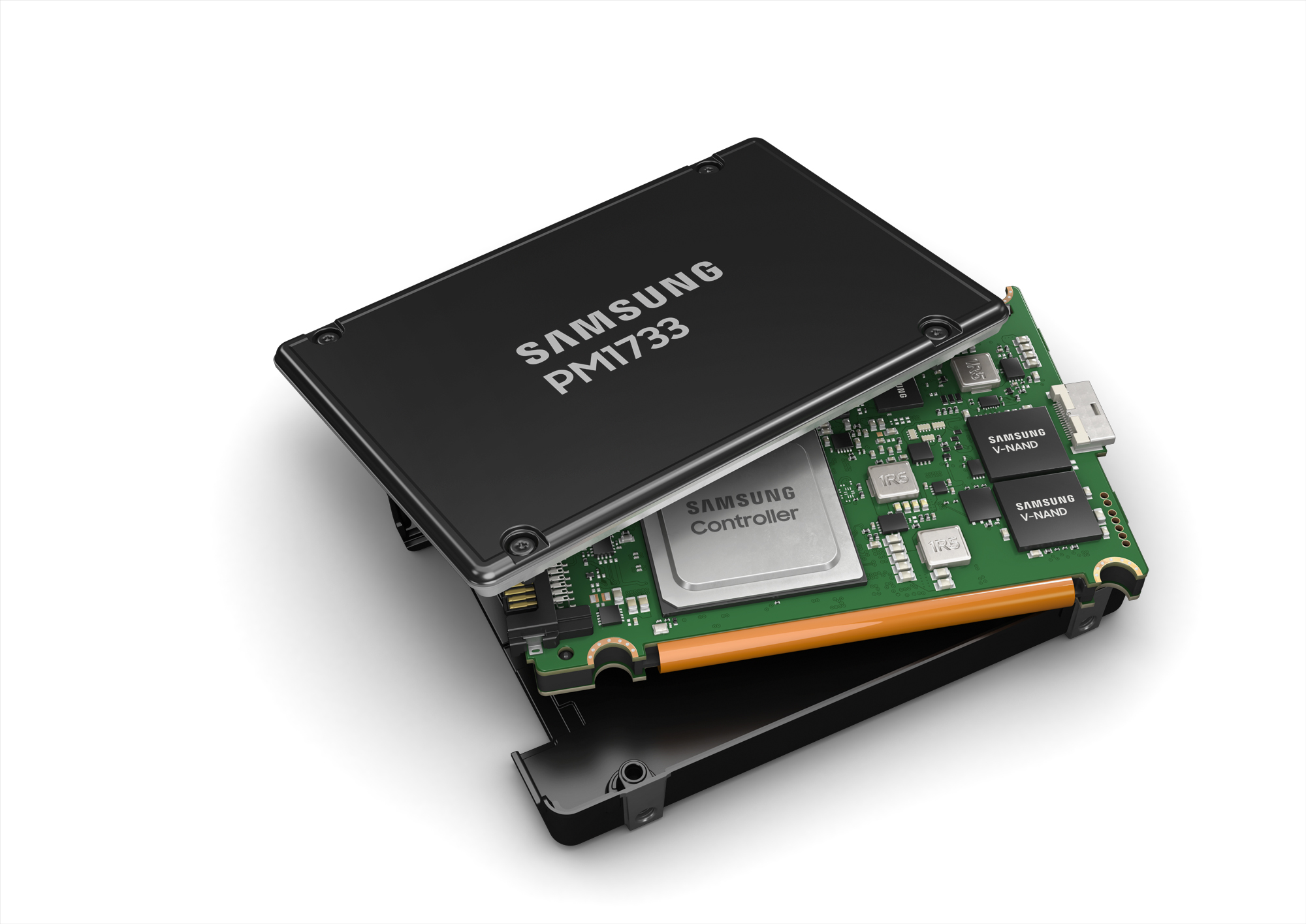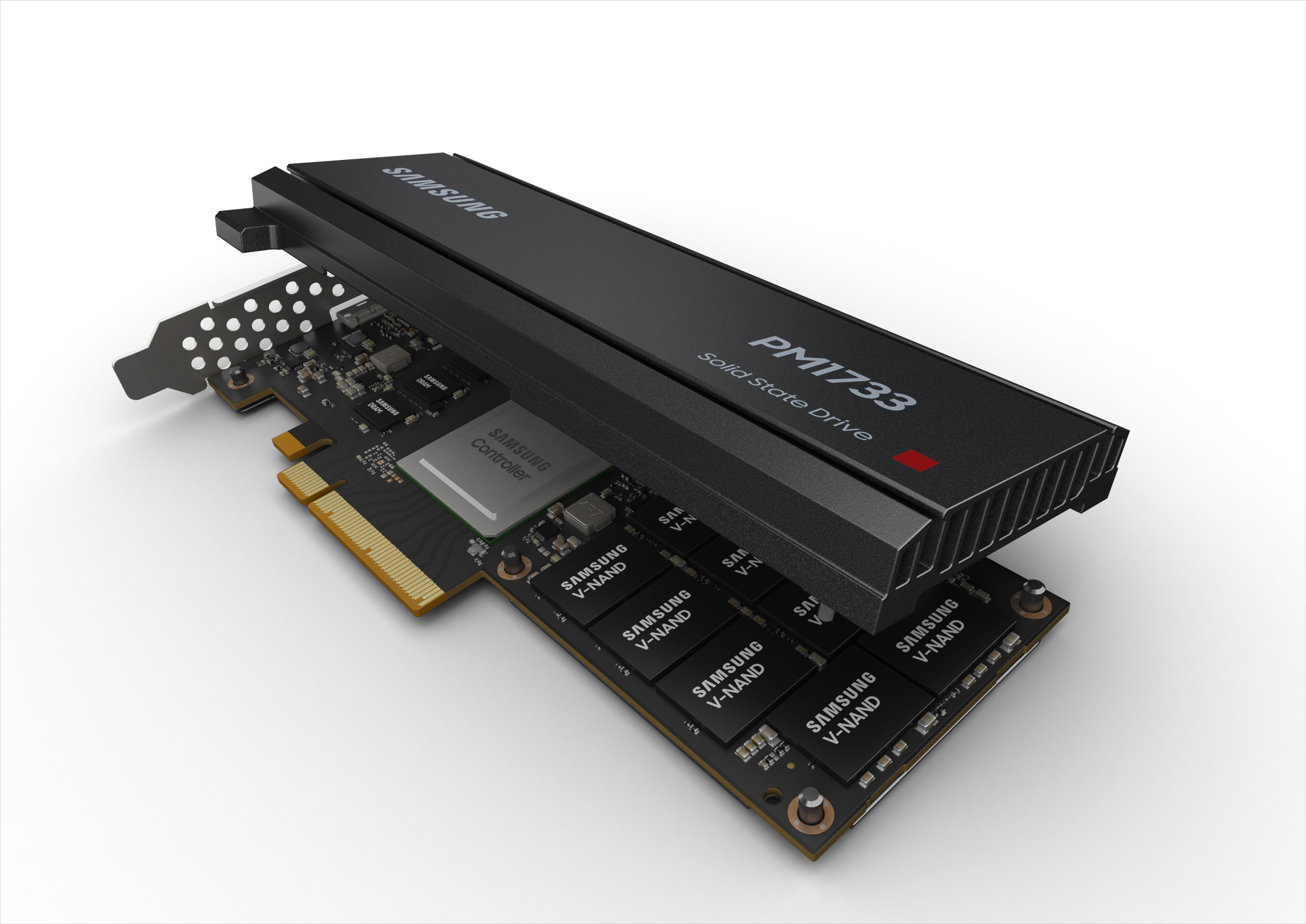Samsung Brings Revolutionary Software Innovation to PCIe Gen4 SSDs for Maximized Storage Performance
Korea on September 19, 2019
Industry's highest-performing SSDs integrate three key software technologies:
'fail-in-place', 'SSD virtualization' and 'V-NAND machine learning'
PM1733 and PM1735 series, offered in 19 models,
deliver twice the speed of Gen3 SSDs at up to 8,000MB/s
Samsung Electronics, the world leader in advanced memory technology, today announced that it has brought the latest software innovations to the company’s most cutting-edge PCIe Gen4 solid state drive (SSD) series, opening up a new paradigm in SSD performance.
“We are combining breakthrough speeds and capacities with revolutionary software solutions as we accelerate expansion in the premium SSD market,” said Kye Hyun Kyung, executive vice president of Memory Solution Product & Development at Samsung Electronics. “We plan to introduce additional innovation led by our most advanced (sixth-generation) V-NAND in helping to trigger a lot more growth in the global IT market.”
3 Software Innovations Create New Paradigm for Ultra-High-Capacity Datacenter SSDs
The three software innovations include: 1) ‘fail-in-place (FIP) technology’ that ensures a ‘never-die’ SSD, 2) ‘virtualization technology’ that provides independent virtual workspaces for multiple users, and 3) ‘V-NAND machine learning technology’ that utilizes big data to accurately verify data validity even when operating at ultra-high speeds.
Samsung’s FIP technology marks a new milestone in the 60-year history of storage by ensuring that SSDs maintain normal operation even when errors occur at the chip level, enabling a never-dying SSD for the first time in the industry. In the past, failure in just one out of several hundred NAND chips meant having to replace an entire SSD, causing system downtime and additional drive replacement cost. SSDs integrated with Samsung’s FIP software can detect a faulty chip, scan for any damage in data, then relocate the data into working chips. For instance, if a fault is identified in any of the 512 NAND chips inside a 30.72TB SSD, the FIP software would automatically activate error-handling algorithms at the chip level while maintaining the drive’s high, stable performance.
Samsung’s SSD virtualization technology allows a single SSD to be subdivided into a maximum of 64 smaller SSDs, providing independent, virtual workspaces for multiple users. Leveraging this software, cloud storage providers can extend their services to a greater number of users with the same amount of resources for optimized product competitiveness. The virtualization technology also enables SSDs to take on some of the virtualized tasks typically carried out by the server CPUs, such as Single-Root I/O Virtualization (SR-IOV), requiring fewer server CPUs and SSDs, thereby reducing the server footprint for enhanced overall IT efficiency.
The company’s V-NAND machine learning technology helps to accurately predict and verify cell characteristics, as well as detect any variation among circuit patterns through big data analytics. This ensures superior data reliability as increasing SSD speeds pose a challenge in reading and verifying data through the extremely rapid voltage pulses. An SSD built with over 100-layer four-bit NAND, which requires considerably more precise cell control than three-bit NAND, is able to generate the higher levels of performance, capacity and reliability needed in server and datacenter storage systems with the machine learning software.
Today’s Highest-Performing NVMe SSDs – Samsung PM1733 & PM1735
Samsung began mass production of its next-generation PCIe Gen4-based PM1733 and PM1735 SSDs last month with twice the speed of the Gen3 SSDs, leveraging on the company’s three core software technologies. The 12.8TB PCIe Gen4 NVMe SSD (PM1735), for example, offers nearly 14 times the sequential performance of a SATA-based SSD, with 8GB/s for read operations and 3.8GB/s for writes. Random speeds measure at 1,450,000 IOPS for reads and 260,000 IOPS for writes. Furthermore, the PM1733 offers single and dual-port options to support server and storage applications, as well as multi-stream writes and SR-IOV.
The two NVMe SSD series are offered in 19 models and come in two form factors – 2.5-inch (U.2) and HHHL (card-type) – with capacities ranging from 0.8TB to 30.72TB to suit the diverse needs of OEMs worldwide. The drives also ensure endurance of one or three drive writes per day (DWPD) over a five-year period.
Samsung plans to soon expand the application of its innovative software technologies into a much wider array of server and datacenter SSDs to actively address global customers’ needs and further strengthen its edge in the premium memory market.
Reference: Samsung PCIe Gen4 SSD lineup
| PM1733 | PM1735 | |
| Form factor & capacity | 2.5-inch (U.2): 6 models 0.96TB, 1.92TB, 3.84TB, 7.68TB, 15.36TB, 30.72TBHHHL (card-type): 4 models 1.92TB, 3.84TB, 7.68TB, 15.36TB |
2.5-inch (U.2): 5 models 0.8TB, 1.6TB, 3.2TB, 6.4TB, 12.8TBHHHL (card-type): 4 models 1.6TB, 3.2TB, 6.4TB, 12.8TB |
| Drive writes per day (DWPD) | 1 DWPD, 5 years | 3 DWPD, 5 years |
| Speed (Sequential read & write) |
2.5-inch (U.2): 6,400MB/s & 3,800MB/s HHHL (card-type): 8,000MB/s & 3,800MB/s |
|

